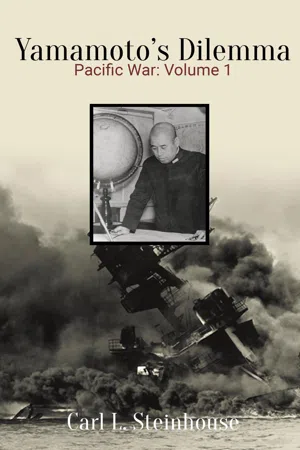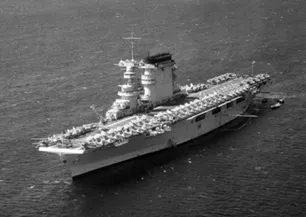
- English
- ePUB (mobile friendly)
- Available on iOS & Android
eBook - ePub
Yamamoto's Dilemma
About this book
Admiral Isoroku Yamamoto, a brilliant admiral in the Japanese Navy was ordered to devise a devastating surprise attack on the American Navy. Always a realist and having spent years in America, warned that Japan could not win a war against the Americans; that Japan would do well for six months, but after that it would be ground down by American industrial might. Ordered by the Emperor to go ahead, he planned the aerial attack on Pearl Harbor with stunning success. But as he predicted, America in 1942, began to push Japan back to its homeland. Yamamoto died in late 1943.
Frequently asked questions
Yes, you can cancel anytime from the Subscription tab in your account settings on the Perlego website. Your subscription will stay active until the end of your current billing period. Learn how to cancel your subscription.
At the moment all of our mobile-responsive ePub books are available to download via the app. Most of our PDFs are also available to download and we're working on making the final remaining ones downloadable now. Learn more here.
Perlego offers two plans: Essential and Complete
- Essential is ideal for learners and professionals who enjoy exploring a wide range of subjects. Access the Essential Library with 800,000+ trusted titles and best-sellers across business, personal growth, and the humanities. Includes unlimited reading time and Standard Read Aloud voice.
- Complete: Perfect for advanced learners and researchers needing full, unrestricted access. Unlock 1.4M+ books across hundreds of subjects, including academic and specialized titles. The Complete Plan also includes advanced features like Premium Read Aloud and Research Assistant.
We are an online textbook subscription service, where you can get access to an entire online library for less than the price of a single book per month. With over 1 million books across 1000+ topics, we’ve got you covered! Learn more here.
Look out for the read-aloud symbol on your next book to see if you can listen to it. The read-aloud tool reads text aloud for you, highlighting the text as it is being read. You can pause it, speed it up and slow it down. Learn more here.
Yes! You can use the Perlego app on both iOS or Android devices to read anytime, anywhere — even offline. Perfect for commutes or when you’re on the go.
Please note we cannot support devices running on iOS 13 and Android 7 or earlier. Learn more about using the app.
Please note we cannot support devices running on iOS 13 and Android 7 or earlier. Learn more about using the app.
Yes, you can access Yamamoto's Dilemma by CARL L STEINHOUSE in PDF and/or ePUB format, as well as other popular books in History & Historical Biographies. We have over one million books available in our catalogue for you to explore.
Information
CHAPTER ONE
Early Career of Yamamoto
Fall of 1924, Kasumigaura Naval Air Station Barracks
After his tour aboard the Fuji, Captain Yamamoto arrived at Kasumigaura Air Station, appointed as executive officer and director of studies. Arriving at his new assignment, none of the students at the base had any idea of who he was. He was a captain and soon to become second in command at the Air Station.
The short man, barely five-feet-three, portly, with close cropped hair did not impress he students, full of themselves as pilots in training.
Yusuo a second-year student, shook his head. “He won’t last long. Where did they find him? He’s barely five feet tall! How is that roly-poly guy going to command us?”
Kazuki, in the same class, laughed. “We’ll make short work of him, even if he is a captain. What does that dumb guy know about flying anyway?”
Yusuo nodded. “We’ll see what happens at the school assembly tomorrow.”
The Next Morning, at School Assembly
Yamamoto watched calmly from the stage as he looked over the students filing into the assembly hall. When they were all seated he moved up to the lectern.
The hum of conversation, and some snickers, filled the room. Yamamoto quickly stopped it.
“I am Captain Isoroku Yamamoto, your new executive officer, and you’d better pay attention.”
That stopped the hum.
“The first thing I will talk on are the dress regulations. You may have thought you joined a boy’s adventure club where you can dress anyway you like and be satisfied looking and dressing like a bunch of bums.”
Yamamoto pointed to his own scalp, gray and shorn to the skull. “If you want to stay in this aviation class, you will get rid of all long hair and look like me. You will not dress sloppily but act like the naval aviators you will become—that is if you are skilled enough and lucky. You might not appreciate it yet, but flying is a dangerous and deadly business. It is not a gift from the gods to you. You don’t fly by instinct but must rely on your instruments and that you can only do by learning how—every day—in your classes.
“This will be no picnic for you. It will involve intense physical training, impossible navigation problems, night flying and, I can’t stress this too strongly, absolute obedience in the cockpit. If you can’t cut it in any of these areas, you will be banished and never allowed back on this base at Lake Kasumigaura. This is no game. If you don’t wise up, you’re out!”
The students quickly found him to be deadly serious. Over the next eighteen months, Yamamoto transformed the playboy school into an elite training facility, graduating only the very best, first-rate, pilots. He had installed oxygen masks in the planes for his flyers and pushed his engineers to study ways of extending a plane’s life.
But Yamamoto would not ask his cadets to do anything he wasn’t willing to do, so he too took flight training, becoming a Navy pilot and, at the same time, developing a better understanding of carrier pilot problems, an understanding other types of naval leaders did not possess. In the process, he became a superb leader in naval avionics.
But one thing he would not do with his cadets is drink alcohol. “When I was an instructor at the Naval Academy” he explained quite frankly to them, “one evening, I went out drinking with my students, and I got so drunk I ended up in a ditch and there I slept until the next morning! That told me I can’t take alcohol and, from then on, I stopped drinking—totally.”
Captain Yamamoto also had the responsibility to keep track of and observe all the activities of the United States Navy, particularly as to whether it was adhering to the Naval Treaty of 1922, which called for the destruction of certain types of warships. In carrying out all his responsibilities he came to appreciate the power of the naval aviation arm and pushed for the building of more aircraft carriers, which Japan did, including converting some cruiser warships into carriers (permitted by the Treaty), and then, pushed for the first ship, built from the keel up, strictly as an aircraft carrier. Yamamoto noted, relying on his sources in the United States, that the Americans were also both building some carriers from scratch and converting several cruisers into carriers.
January 1925, Washington, D.C.
Yamamoto arrived in Washington, in his position as a Japanese naval attaché. Kiyoshi Hasegawa, the departing naval attaché, welcomed his replacement.
“Before I leave for Japan,” Hasegawa informed the new arrival, “I am going to visit Havana.”
Yamamoto eyes widened. “I hear it’s the loosest city in the Western Hemisphere; that anything goes—gambling, women, cigars. You name it, they have it. May I join you? I hear they play roulette there in the gambling houses—and I love the gambling tables, especially roulette!”
Hasegawa smiled. “Be my guest, I’d love the company.”
Yamamoto gambled, won, and came back with a large bunch of Havana cigars to give out to his visitors in his capacity as naval attaché.
Yamamoto gambled at bridge with his American counterparts and they respected his abilities and his intellect. So much so that they convinced naval intelligence to maintain a dossier on him. But his job was not all play. While he enjoyed the game of bridge immensely, playing with American naval officers gave him an opportunity, which he did not pass up, to learn much about the U.S. Navy.
One surprised American lieutenant told Yamamoto during a bridge game, “I am surprised at your abilities at the game of bridge. It is not a Japanese game and I have found very few Japanese with your abilities at this card game.”
Yamamoto smiled. “Cards are no great mystery to me. As you may know, our language has no alphabet and each word or syllable is represented by a specific character. So, I have to keep five thousand ideographs in my head.” Now Yamamoto laughed out loud. “Compared to that, it’s a child’s play for me to remember fifty-two cards.”
He did not let gambling interfere with his duties, one of the most important of which was to observe all the activities of the U.S. Navy, particularly its adherence to the Naval Treaty of 1922, calling for the reduction of naval warships. His major concern was in carriers and aviation. Thanks in part to his influence, Japan led the world in carrier building.
The Naval Treaty of 1922 encouraged the building of carriers because it allowed any nation to convert a ship under 33,000 tons to an aircraft carrier without penalty. Thus many cruisers, rather than being destroyed under the Treaty, were converted to carriers and perfectly legal under the agreement. The U.S. carriers Lexington and Saratoga, which would play an important part in the coming war, were actually converted cruisers. By 1942, these carriers had been significantly upgraded with radar technology and better and more antiaircraft guns.

USS Lexington
All his activities were not solely business. He studied the life and writings of Abraham Lincoln. He could identify with him as a man born in poverty like himself, living in a simple log cabin not much different from his parents’ modest dwelling in the city of Nagaoka. But ...
Table of contents
- AUTHOR’S NOTE
- EXCERPT FROM THE BOOK
- PREFACE
- PREQUEL
- CHAPTER ONE
- CHAPTER TWO
- CHAPTER THREE
- CHAPTER FOUR
- CHAPTER FIVE
- CHAPTER SIX
- CHAPTER SEVEN
- CHAPTER EIGHT
- CHAPTER NINE
- CHAPTER TEN
- CHAPTER ELEVEN
- CHAPTER TWELVE
- CHAPTER THIRTEEN
- CHAPTER FOURTEEN
- CHAPTER FIFTEEN
- CHAPTER SIXTEEN
- CHAPTER SEVENTEEN
- CHAPTER EIGHTEEN
- EPILOGUE
- BIBLIOGRAPHY
- OTHER BOOKS BY AUTHOR